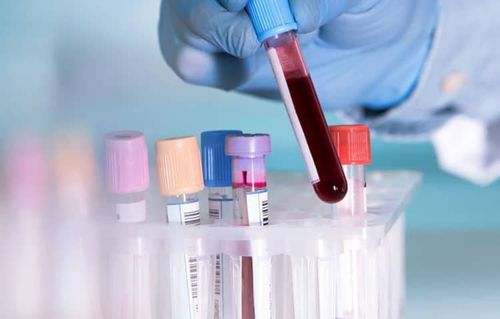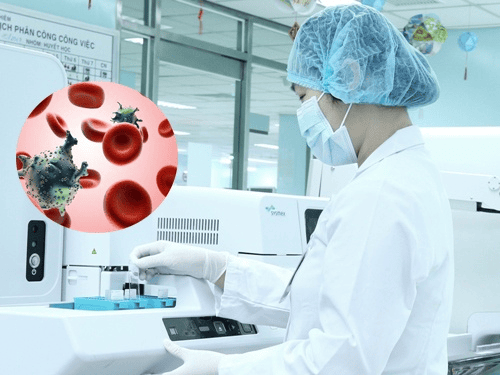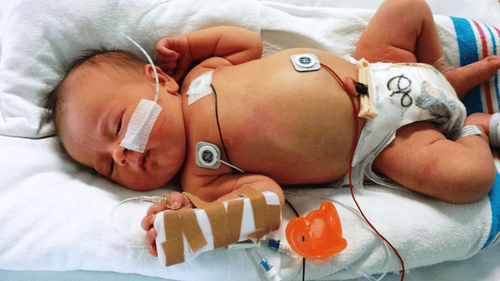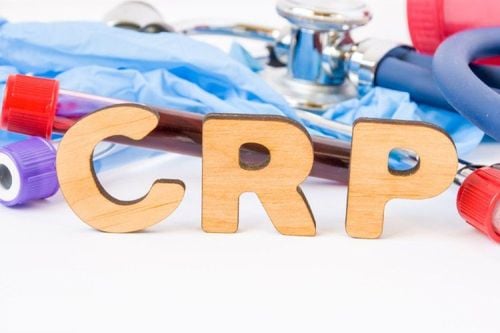This is an automatically translated article.
The article was consulted with Specialist Doctor I Dang Thi Ngoc Chuong - Department of Pediatrics - Neonatology, Vinmec Central Park International General Hospital.Neonatal sepsis is a dangerous disease with the second highest mortality rate after respiratory distress syndrome. Therefore, early diagnosis based on neonatal infection diagnostic test results is essential for timely intervention.
1. Neonatal infections
Neonatal sepsis are infections that occur from birth to 28 days of age. Neonatal infections have antenatal, intrapartum, and postnatal causes. Neonatal sepsis has the second highest mortality rate after neonatal respiratory distress syndrome.Neonatal infections can be transmitted from mother to child, and there is a high risk for premature infants.
The clinical presentation of neonatal sepsis is often indistinct. Typical symptoms of neonatal sepsis are:
Sudden high fever, or hypothermia, sometimes with convulsions Presented with arrhythmia, often shallow rapid breathing, whining Tachycardia, bulging fontanelle, low blood pressure The child is fussy, unable to suckle, refuses to suckle, vomits with symptoms of diarrhea The facial skin is pale, pale, may be accompanied by a skin rash or hemorrhagic nodules. Other manifestations such as bacterial infection in the umbilicus, skin or other sources of infection.

2. Diagnostic tests for neonatal infections
Several tests are used to diagnose neonatal infection such as complete blood count, blood culture, gastric juice culture, urine culture, etc.2.1 Blood count test Complete blood count reflects response status bone marrow response to infections in the body. The primary response to all infections is an increase in the white blood cell count. The white blood cell count increases above 25,000/mm3 or decreases below 5000/mm3. Leukopenia usually occurs in the early stages of the disease. A low neutrophil count usually suggests a serious bacterial infection. The platelet count usually falls below 100,000/mm3.
CRP is an active ingredient that increases in quantity early and is the leading sensitizer in the chain of proteins involved in the response at the early stages of acute inflammation. Usually, about 3-6 hours after the stimulation of the inflammatory process, the CRP index will begin to increase and peak between 36-48 hours after inflammation. CRP is a component that cannot move across the placenta. CRP index (+) when increased above 10mg/liter and does not increase in chronic diseases.
Permissible CRP index:
Rule out neonatal infection. Or, allow early discontinuation of antibiotics for the child. Or, monitor antibiotic response for neonatal infections with elevated CRP. Note, CRP alone has no diagnostic value for infection. 2.2 Culture of test fluid Culture is called the mainstay diagnostic method in the diagnosis of infectious diseases in general and in neonatal infections in particular.
Culture of fluid or blood culture to confirm the presence of bacteria in these pathological cases. The minimum volume of inoculum requires 1 ml of fluid or blood.
If cultures give positive results on two different samples, the value is bacteriostatic.
Blood culture: Blood culture (+) is the gold standard in the diagnosis of neonatal sepsis, especially sepsis. Urine culture: To confirm urinary tract infection. Purulent culture: In the skin or in the navel. Specimens can be taken at all sites with pus-filled foci and isolated to determine the exact cause of the disease. Pus can be a thick liquid or mucus with a red or yellow, green, foul-smelling odor. Note that pus culture should be done before giving the patient treatment to get the most accurate results. Stool culture: Taking stool samples for culture can help diagnose inflammatory conditions in the digestive tract such as diarrhea, digestive disorders, purulent or bloody stools... Stool cultures should be taken. Specimens at an early stage, as soon as possible and taken before giving the patient antibiotic treatment. Culture of gastric juice: Determine the status of gastrointestinal infections in general, stomach in particular. Special attention should be paid to cases of infection caused by HP bacteria. 2.3 Vaginal fluid test Take the mother's vaginal fluid for testing because the baby can be infected with the disease from the mother during childbirth. The test of vaginal discharge will help isolate viruses or bacteria or determine if the cause is caused by a fungus so that there can be better treatment.

Test of cerebrospinal fluid :
If there is an increased lymphocyte count, the diagnosis is caused by a viral infection. If there is an elevated neutrophil count: Diagnose a bacterial infection. Other diagnostic tests Chest x-ray. Do a blood clotting test. Liver and kidney function tests. Electrolytes.
3. Definitive diagnosis of neonatal infection
Diagnosis of neonatal sepsis should be based on clinical manifestations with laboratory test results and risk factors. If the clinical presentation is clear, it can be confirmed with certainty that the infant has neonatal sepsis regardless of whether the laboratory test results are negative or positive.If in case the patient has clinical signs of suspected infection The test result is positive: The doctor will treat the infection If the test result is negative, he can give further monitoring and do the test again to diagnose. If the patient has a clinical presentation that is completely non-diagnostic, whether the laboratory test is negative or positive, it is advised to follow up further before starting treatment.
Diagnosis of severity when neonatal infection is accompanied by some of the following symptoms:
Respiratory failure Circulatory failure Impaired function of 2 or more different organs in the body In summary, infection Newborn is one of the diseases with the second highest risk of death after respiratory distress syndrome, so it is necessary to diagnose early signs of neonatal infection and do tests for timely treatment and prevention. effective. Mothers need to regularly monitor the baby's condition and abnormalities so that the baby can see a doctor for a timely examination.
Pediatrics department at Vinmec International General Hospital is the address for receiving and examining diseases that infants and young children are susceptible to: viral fever, bacterial fever, otitis media, pneumonia in children, .... With modern equipment, sterile space, minimizing the impact as well as the risk of disease spread. Along with that is the dedication from the doctors with professional experience with pediatric patients, making the examination no longer a concern of the parents.
As a key area of Vinmec Health system, Pediatrics Department always brings satisfaction to customers and is highly appreciated by industry experts with:
Gathering a team of top doctors and nurses in Pediatrics : consists of leading experts with high professional qualifications (professors, associate professors, doctorates, masters), experienced, worked at major hospitals such as Bach Mai, 108.. Doctors All doctors are well-trained, professional, conscientious, knowledgeable about young psychology. Besides domestic pediatricians, the Department of Pediatrics also has the participation of foreign experts (Japan, Singapore, Australia, USA) who are always pioneers in applying the latest and most effective treatment regimens. . Comprehensive services: In the field of Pediatrics, Vinmec provides a series of continuous medical examination and treatment services from Newborn to Pediatric and Vaccine,... according to international standards to help parents take care of their baby's health from birth to childhood. from birth to adulthood Specialized techniques: Vinmec has successfully deployed many specialized techniques to make the treatment of difficult diseases in Pediatrics more effective: neurosurgery - skull surgery, stem cell transplantation. blood in cancer treatment. Professional care: In addition to understanding children's psychology, Vinmec also pays special attention to the children's play space, helping them to have fun and get used to the hospital's environment, cooperate in treatment, improve the efficiency of medical treatment.
Please dial HOTLINE for more information or register for an appointment HERE. Download MyVinmec app to make appointments faster and to manage your bookings easily.














